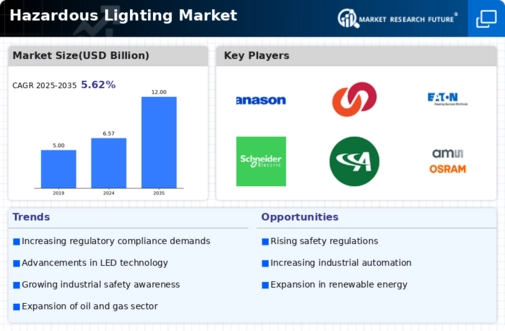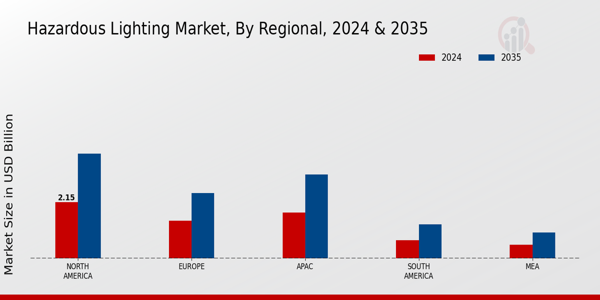Market Growth Projections
The Global Hazardous Lighting Market Industry is projected to experience robust growth in the coming years. With a market size of 6.57 USD Billion in 2024, the industry is anticipated to expand significantly, reaching an estimated 12 USD Billion by 2035. This growth trajectory suggests a compound annual growth rate (CAGR) of 5.63% from 2025 to 2035. Factors contributing to this growth include increased industrial safety regulations, technological advancements, and rising demand from sectors such as oil and gas. As industries continue to prioritize safety and efficiency, the hazardous lighting market is likely to evolve, adapting to new challenges and opportunities.
Expansion of Manufacturing Facilities
The expansion of manufacturing facilities across various sectors is significantly influencing the Global Hazardous Lighting Market Industry. As new plants are established, particularly in regions with growing industrial bases, the need for compliant hazardous lighting solutions becomes paramount. Industries such as chemicals, pharmaceuticals, and food processing require specialized lighting to meet safety standards. This expansion is not only limited to developed countries but is also evident in emerging economies, where industrial growth is accelerating. Consequently, the market is poised for substantial growth, with projections indicating a potential market size of 12 USD Billion by 2035, driven by the increasing number of manufacturing facilities.
Growing Awareness of Workplace Safety
There is a growing awareness of workplace safety among employers and employees, which is positively impacting the Global Hazardous Lighting Market Industry. Organizations are increasingly recognizing the importance of investing in proper lighting solutions to enhance safety and productivity in hazardous environments. This awareness is often driven by training programs and safety campaigns that emphasize the risks associated with inadequate lighting. As a result, companies are more likely to allocate budgets for upgrading their lighting systems to meet safety standards. This trend is expected to contribute to the market's growth, with an anticipated market size of 6.57 USD Billion by 2024, reflecting the industry's response to heightened safety consciousness.
Rising Demand from Oil and Gas Sector
The oil and gas sector is a major contributor to the growth of the Global Hazardous Lighting Market Industry. This sector operates in environments that often involve flammable gases and liquids, necessitating specialized lighting solutions that can operate safely under such conditions. The demand for explosion-proof lighting fixtures is particularly high, as these products are designed to prevent ignition in hazardous areas. As the global energy demand continues to rise, the oil and gas industry is likely to invest heavily in hazardous lighting solutions to ensure safety and compliance. This trend is expected to bolster market growth, with a projected CAGR of 5.63% from 2025 to 2035.
Increasing Industrial Safety Regulations
The Global Hazardous Lighting Market Industry is experiencing growth due to the increasing emphasis on industrial safety regulations. Governments worldwide are implementing stringent standards to ensure worker safety in hazardous environments. For instance, the Occupational Safety and Health Administration (OSHA) in the United States mandates specific lighting requirements in workplaces with hazardous conditions. This regulatory pressure is driving industries to invest in advanced hazardous lighting solutions, which are designed to withstand extreme conditions and prevent accidents. As a result, the market is projected to reach 6.57 USD Billion in 2024, reflecting the industry's commitment to compliance and safety.
Technological Advancements in Lighting Solutions
Technological advancements are playing a pivotal role in the expansion of the Global Hazardous Lighting Market Industry. Innovations such as LED technology and smart lighting systems are enhancing the efficiency and effectiveness of hazardous lighting solutions. These advancements not only improve energy efficiency but also extend the lifespan of lighting fixtures, reducing maintenance costs. For example, LED fixtures designed for hazardous locations can last up to 50,000 hours, significantly outpacing traditional lighting options. As industries increasingly adopt these technologies, the market is expected to grow, potentially reaching 12 USD Billion by 2035, driven by the demand for more sustainable and reliable lighting solutions.























